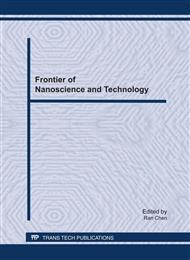[1]
Choi: Enhancing thermal conductivity of fluids with nano-particles. ASME FED 231(1995), 99-103.
Google Scholar
[2]
Xiaolin Jia et al.: Technology development of nano-power dispersion. Non-metallic minerals, 26(2003): 1-3.
Google Scholar
[3]
Zukang Zhou et al.: The basis of colloid chemistry. B.J.: Beijing university Press. (1996).
Google Scholar
[4]
R.X. Wang, Q.P. Wu, Y.Z. Wu, Use of nanoparticles to make mineral oil lubricats feasible for use in a residential air conditioner employing hydro-fluorocarbons refrigerants. Energy and Buildings 42(2010), 2111-2117.
DOI: 10.1016/j.enbuild.2010.06.023
Google Scholar
[5]
G.L. Ding, H. Peng, W.T. Jiang, Y.F. Gao: The migration characteristics of nanoparticles in the pool boiling process of nanorefrigerant and nanorefrigerant–oil mixture. International Journal of Refrigeration 32(2009), 114-123.
DOI: 10.1016/j.ijrefrig.2008.08.007
Google Scholar
[6]
Z.H. Liu, L. Liao: Sorption and agglutination phenomenon of nanofluids on a plain heating surface during pool boiling. International Journal of Heat and Mass Transfer 51(2008), 2593–2602.
DOI: 10.1016/j.ijheatmasstransfer.2006.11.050
Google Scholar
[7]
Y.B. Zong: The Saturated Vapor Pressure of Oil-refrigerant and nano-particles /oil-refrigerant. B.J.: Beijing University of Civil Engineering and Architecture. (2008).
Google Scholar
[8]
J.F. Lou: Mechanisms and Experimental Correlation of the Saturated Vapor Pressure of Refrigerant Containing Nano-refrigeration-oil. B.J.: Beijing University of Civil Engineering and Architecture. ( 2011).
Google Scholar
[9]
S.S. Bi, L. Shi, H.L. Yong, R.X. Wang: Investigation on Materials Compatibility Using Nanoparticles Additive in Refrigerating System. Journal of RefrigerationVol. 27(2006): 1-4.
Google Scholar
[10]
M.A. Kedzierskia, M. Gong: Effect of CuO nanolubricant on R134a pool boiling heat transfer. International Journal of Refrigeration 32(2009): 791-799.
DOI: 10.1016/j.ijrefrig.2008.12.007
Google Scholar
[11]
M.A. Kedzierskia: Effect of Al2O3 Nanolubricant on R134a Pool Boiling Heat Transfer. International Journal of Refrigeration 34(2011): 498-508.
DOI: 10.1016/j.ijrefrig.2010.10.007
Google Scholar
[12]
P H. eng, G.L. Ding, H.T. Hu, W.T. Jiang, D.W. Zhuang, K.J. Wang: Nucleate pool boiling heat transfer characteristics of refrigerant/oil mixture with diamond nanoparticles. International Journal of Refrigeration 33(2010), 347-358.
DOI: 10.1016/j.ijrefrig.2009.11.007
Google Scholar
[13]
M.A. Kedzierskia: Effect of bulk lubricant concentration on the excess surface density during R123 pool boiling. International Journal of Refrigeration 25( 2002): 1062-1071.
DOI: 10.1016/s0140-7007(02)00006-3
Google Scholar
[14]
K. Lee, Y. Hwang, S. Cheong, L. Kwon, S. Kim, J. Lee: Performance evaluation of nano-lubricants of fullerene nanoparticles in refrigeration mineral oil. Current Applied Physics 9(2009): e128-e131.
DOI: 10.1016/j.cap.2008.12.054
Google Scholar
[15]
H.L. Yong, S.S. Bi, L. Shi: Experiment research on the different TiO2 nanoparticles concentrations for HFC134a/mineral oil refrigerator. Journal of engineering thermophysics 29(2008): 25-27.
Google Scholar
[16]
K.J. Park, D.S. Jung: Boling heat transfer enhancement with carbon nanotubes for refrigerants used in building air-conditioning. Energy and Buildings 39 (2007), 1061–1064.
DOI: 10.1016/j.enbuild.2006.12.001
Google Scholar
[17]
K.J. Park, D.S. Jung: Enhancement of nucleate boiling heat transfer using carbon nanotubes. International Journal of Heat Mass Transfer 50(2007): 4499–4502.
DOI: 10.1016/j.ijheatmasstransfer.2007.03.012
Google Scholar
[18]
P. Naphon, D. Thongkum, P. Assadamongkol: Heat pipe efficiency enhancement with refrigerant–nanoparticles mixtures. Energy Conversion and Management 50(2009) : 772–776.
DOI: 10.1016/j.enconman.2008.09.045
Google Scholar
[19]
S.S. Bi, K. Guo, Z.G. Liu, J.T. Wu: Performance of a domestic refrigerator using TiO2-R600a nano-refrigerant as working fluid. Energy Conversion and Management 52(2011): 733-737.
DOI: 10.1016/j.enconman.2010.07.052
Google Scholar
[20]
J.K. Kim, J.Y. Jung, Y.T. Kang: Absorption performance enhancement by nano-particles and chemical surfactants in binary nanofluids. International Journal of Refrigeration 30(2007): 50-57.
DOI: 10.1016/j.ijrefrig.2006.04.006
Google Scholar


